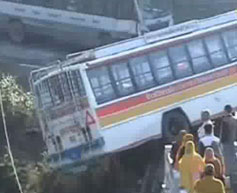Since politicians are generally suspected of hiding their self-serving interest under homilies, it is unlikely that there are many takers for L.K. Advani’s claim that his recent rath yatra – his sixth trademark venture – has nothing to do with his prime ministerial ambition.
However, his purported goal may have already hit a few road bumps. For instance, he had set off in something of a hurry to, first, cash in on the momentum against corruption created by Anna Hazare and, secondly, because of his belief that a government under siege may bring the general elections forward.
Neither of the two expectations seems realistic at the moment. While the earlier euphoria about Anna has been dissipated by the revelations about the dubious activities of some of his close supporters (and his own preference for flogging offenders), the worst is apparently over for the government largely because of failures of the civil activists.
But since the change of scene does not mean that Advani will quietly withdraw to a retirement home for octogenarians, it is the BJP which will now have to contend with a plethora of prime ministerial aspirants in the party even if the contest is still three years away.
Although BJP president Nitin Gadkari has said that a nominee can be chosen in “a fraction of a second”, it is obvious that the task will not be easy. For a start, no one in the party can be in any doubt that Advani is a serious candidate considering that he has so emphatically rejected the BJP’s efforts to sideline him by making him the largely ornamental chairman of the parliamentary party after he insisted on continuing as leader of the opposition in the Lok Sabha till 2014.
But Advani is not the only one in the ring. If he hoisted the anti-corruption banner to present his credentials, Narendra Modi also suddenly announced his presence by resorting to the unlikely ruse of staging a ‘sadbhavna’ (goodwill) show in aid of “social harmony” – an objective for which the Gujarat chief minister was not hitherto known.
But, like Anna’s stumbles, Modi, too, has run into trouble with the court cases against him, the police officer Sanjiv Bhatt’s allegations about the chief minister’s complicity in the 2002 riots and the continuing denial of American visa for him, a snub which does not enhance Gujarat’s ‘asmita’ (self-respect) on which Modi is so fond of harping.
It would, therefore, be reasonable to assume that Modi’s sadbhavna rally was a wasted effort because it might not propel him to the frontline of the prime ministerial race. Besides, his tussles with Gadkari are no secret, especially after the latter inducted an apparatchik, who is Modi’s bête noire, into a position of importance in the party. Since the move was apparently at the behest of the Rashtriya Swayamsewak Sangh (RSS), it is also obvious that the pater familias of the Sangh Parivar is against Modi.
The scene has been further complicated by the faint hints that Gadkari himself is not averse to throwing his hat into the ring. His weight-reduction regimen and decision to contest a Lok Sabha seat, most probably from his stronghold of Nagpur, have fuelled speculations in this regard. His objective may be to stymie Advani – and Modi. But, since he is known to have the RSS’ backing, he cannot be ruled out.
What this internal kerfuffle means is that the BJP is yet to settle down. Unless it can sort out the leadership issue to the satisfaction of Advani and Gadkari, not to mention Sushma Swaraj and Arun Jaitley, who were the frontrunners before the rath yatri and the party chief entered the field, the party is unlikely to be seen as a credible alternative.
Its difficulties will be all the greater if the Congress can pull itself together with a few more definitive steps like allowing foreign investment in the retail sector, a move that has pleased the “great Indian middle class”, to quote Communist Party of India (CPI) leader A.B. Bardhan’s sarcastic compliment to the voting prowess of the 250-million-strong section after the Left’s resounding defeat in 2009.
If the BJP missed the bus in 2004 because of the Gujarat riots, as Atal Bihari Vajpayee said, and in 2009 because its prime ministerial candidate, Advani, did not measure up to Vajpayee’s exacting standards, it may fall short yet again because of the same problem – the absence of a leader of stature with pan-Indian appeal. Although Advani has been modelling himself on Vajpayee by posing as a moderate, he is not convincing, largely because of his fiery past when he flew the Hindutva flag with great fervour.
More than personalities, however, the BJP’s main problem lies in the fact that it is simply not trusted by the minorities and the liberal Hindus because it has been unable to shed its communal image. As long as this unsavoury reputation remains, Delhi will remain ‘dur ast’ (far away) for it.
IANS



